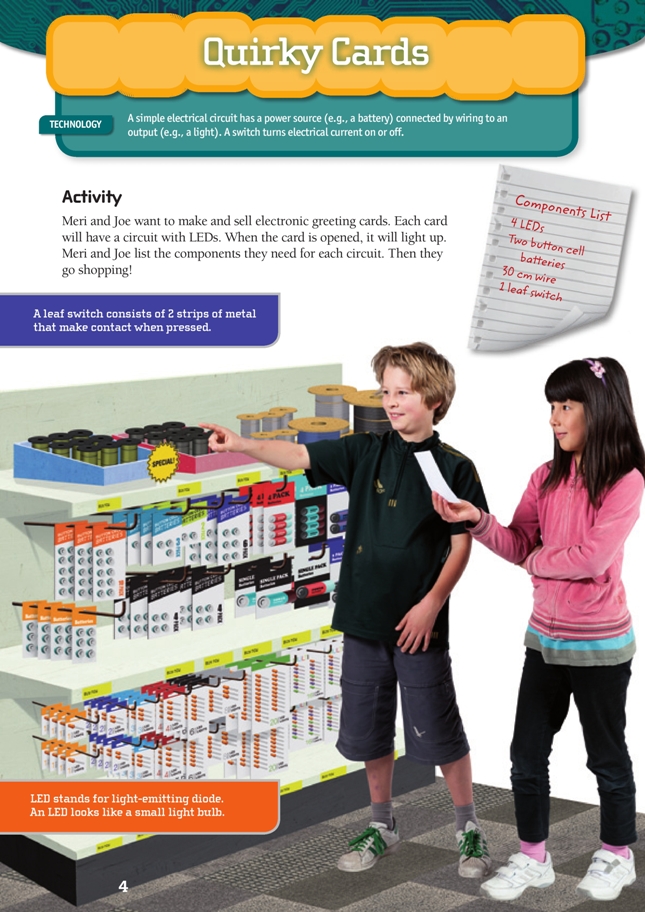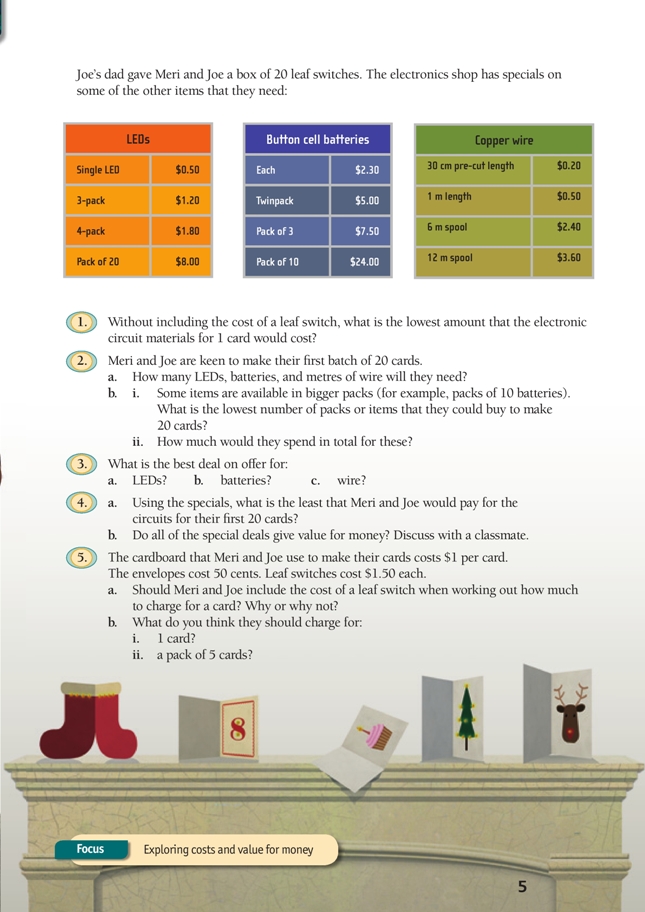This is a level 3 activity from the Figure It Out series.
A PDF of the student activity is included.
Click on the image to enlarge it. Click again to close. Download PDF (698 KB)
Numeracy involves developing mathematical skills and knowledge to meet the demands of everyday life. In this activity, students compare the cost of electronic circuit components. Using comparisons to inform decision making and knowing how to evaluate the benefit of “specials” are important everyday skills.
In this activity, the students use number strategies to find the unit price of items.
The information can be organised in a table:
| LEDs | Unit price | |
| Single | $0.50 | $0.50 |
| 3-pack | $1.20 | $0.40 |
| 4-pack | $1.80 | $0.45 |
| Pack of 20 | $8.00 | $0.40 |
| Button cell batteries | Unit price | |
| Each | $2.40 | $2.40 |
| Twinpack | $5.00 | $2.50 |
| Pack of 3 | $7.50 | $2.50 |
| Pack of 10 | $24.00 | $2.40 |
| Copper wire | Unit price (per metre) | |
| 30 cm pre-cut length | $0.20 | $0.67 |
| 1 m length | $0.50 | $0.50 |
| 6 m spindle | $2.40 | $0.40 |
| 12 m spindle | $3.60 | $0.30 |
To find the cost of each unit, the students need to divide by 2, 3, 4, 6, 10, 12 and 20. A useful strategy is to divide in steps. For example, dividing by 4 is the same as dividing by 2 and then dividing by 2 again. Similarly, dividing by 2 and then by 10 gives the same result as dividing by 20. You could use materials such as multilink cubes to demonstrate this. For example, if 20 ÷ 4 = 5 is a known basic fact, use cubes to demonstrate that 20 ÷ 2 = 10 and then 10 ÷ 2 = 5 gives the same result as dividing 20 by 4. Ask students to explore and test this relationship further using known facts. For reinforcement of this concept, see Proportional Packets from NDP Book 6: Teaching Multiplication and Division.
If students struggle to add or multiply prices, adapt the task by asking the student to work with cents. For example, for question 1, use 120 + 50 + 230 + 230 + 20 instead of $1.20 + $0.50, and so on.
Ask students to find examples of specials in supermarket advertising materials and to compare the special price with the ordinary price. They can also compare the unit prices on the shelf labels in supermarkets. Often “specials” are more costly than the non-specials of the same product in larger amounts.
In question 5, there is no “right” answer for the cost of a single card or a pack of 5. Students need to consider how much profit is needed for the enterprise to be worthwhile, while at the same time choosing a price that will encourage people to splash out and buy a “value pack” of 5 cards.
Dealing with uncertainty and variation and deciding whether a price is reasonable helps students to develop the key competency thinking.
Technology-related student activities
Learning about electrical circuits would probably fit within the science learning area, but students can use this authentic context to produce a technological solution. With a small amount of knowledge, teachers can facilitate students’ learning by helping them design functional electronic models. There are several commercial products available that would augment the typical school resource kit of batteries, wire, and bulbs and allow young students to make robust circuits. Some kits will have simple instructions, or a parent may be available to help.
Websites such as www.can-do.com/uci/lessons99/electricity.html are useful (search under “easy circuits”).
- Emulate Meri and Joe and make electronic birthday cards with LEDs.
- Investigate using an LDR (light-dependent resistor) and a buzzer in a circuit to construct a simple burglar alarm.
- Construct a doll’s house for the junior school. Place simple circuits for lights, door bells, and switches.
- Construct portable fans with small electric motors and blades made from soft material.
- Design and construct quiz boards to reinforce mathematical understanding. (This would make a good science fair project.) See:
− www.darkstar.cc/Discovery/ElectricExam.htm
− http://teachingtreasures.com.au/K-10Projects/quizboard/quizboard.htm
Electronic components for each of the above activities should cost less than $10.00.
Exploring the technology-related context
Technological practice is responding to a need or opportunity. Teachers could encourage students to choose an appropriate event or recipient for the cards and to suggest suitable attributes.
Answers to activity
1. $6.70, for 4 LEDs + 2 batteries + 30 cm of wire. ($1.70 [for a single LED and a pack of 3 LEDs] + $4.80 for two single batteries + $0.20 for 30 cm of wire)
2. a. 80 LEDs, 40 batteries, 6 m (600 cm) of wire
b. i. 9. (4 x 20-pack LEDs + 4 x pack of 10 batteries + 1 x 6 m spool of wire)
ii. $130.40. ($8.00 x 4 + $24 x 4 + $2.40)
3. a. 3 for $1.20 ($0.40 per LED) or 20 for $8.00 ($0.40 per LED)
b. Single battery or a pack of ten ($2.40 per battery)
c. 12 m for $3.60 (30c per metre)
4. a. $130.40. (40 batteries x 2.40 each = $96. 80 LEDs x 0.40 = $32. 12 m of wire is too much, so they should still buy 6 m at $2.40. Total = 96.00 + 32.00 + 2.40 = $130.40.)
b. No. The batteries are the same for singles as packs of ten. An LED 4-pack is more expensive than a 3-pack plus a single.
5. a. Answers will vary. The cheaper the cards are, the more they are likely to sell. However, after they have made 20 cards, they will need to buy leaf switches and may lose customers if they put the price up.
b. i. The electronic circuit materials cost $6.50 for each card ($130.40 ÷ 20 = $6.52), leaf switches are $1.50 each, and the cardboard and envelope are $1.50. The total cost of the materials, including a leaf switch, is $9.52, but Meri and Joe will probably want to make some profit. Suggested charge: $11.00 (answers will vary).
ii. The materials for 5 cards cost $47.60 ($9.52 x 5). The answer should be somewhere between $47.60 (no profit) and 5 times the answer to b i. A discount will encourage people to buy a pack of 5, but Meri and Joe still want to make a profit. Suggested price: $52.00 (answers will vary).

